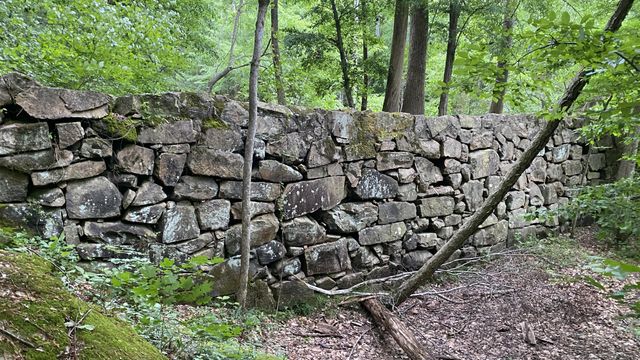Abandoned mills, homes, graves hidden in woods at Umstead Park date back to 1800s
Before the modern day hiking trails, Umstead Park had a different kind of adventure: The land was home of an entire community--with mills, schools, churches and farms--and those ruins are still hidden out in the woods.
Posted — UpdatedEvery now and then, a watchful hiker may catch a glimpse of a lone, stone chimney hiding amongst the trees. The occasional pile of rubble and wooden planks reveals the history of old homesteads, where early Wake County farmers tilled the land.
And if you ever catch a glimpse of tulips growing just off the trail – well, those flowers have a special meaning.
"Anywhere you see tulips or a large oak tree, that's where someone's front yard used to be," said Reggie King, whose family tree has deep roots in the Umstead soil.
Foundations, chimneys and millstones: Remains of a thriving farm community
"This was a thriving, self-contained community," said King. "It produced its own cornmeal. It had a dairy farm with milk cows, a grist mill, a cotton mill and a saw mill. They all lived there, and the jobs were all right there, too."
The community also had a school, a church and a store that were also destroyed when the farming community was purchased in the 1930s, according to Weber's book.
Following hand-drawn maps to abandoned sites
The Page homestead and Company Mill
In 1810, the Page family built a mill on Crabtree Creek, which was later re-named Company Mill, a name many hikers may recognize from the Company Mill Trail. The remains of this community mill still stand in the park, while the George Lynn Mill on Sycamore Creek and several others have less substantial remains. The dam forms a large and visible landmark, where families and children can be found climbing, fishing and playing on nice days.
The Company Mill's millstone was preserved and decorated with a bronze plaque explaining the history of the site -- an honor many of the abandoned structures, overgrown and crumbling in the woods, did not receive.
Antique farm structure
Some sources have said this pile of stones and wooden planks could be the remains of a Page-family structure, given its proximity to the Page family plot.
The King homestead
It is difficult to believe the small remains of a chimney – all that remains of the King homesite, which, according to Reggie King, would have been considered grand for its era and location.
The Young and King family grave sites
Imagine hiking off-trail on a summer day and stumbling upon a graveyard in the woods of Umstead. Families in the 1800s often buried their loved ones near their homesite, leading to the creation of several graveyards across the park.
Brick explosives magazine
Two explosives magazines built for holding dynamite are hidden somewhere in the park. A brick structure with a flat roof, thick walls, no windows and a gaping door matches the description of an explosives magazine near Crabtree Creek. "Both are single-story, masonry, shed-roofed structures with single-door openings," wrote Weber. One is along Sycamore Creek Trail.
An old stone chimney and fireplace
The remains of an old stone chimney and fireplace can also been spotted in the woods. Many foundations of barns and chicken coops, freestanding chimneys and other foundational remains are still standing -- and some are still waiting to be found and identified.
A forgotten way of life in Wake County
"Look at the bottom of their shoes," said King. "You can tell life was rough."
Despite the tough times, King's family members have had long life spans. He said, "My father and all of his siblings were born there in that park. My Uncle Bruce just passed away at 90. Aunt Hazel is 99, and still has her faculties about her."
The King family played a major role in the community, donating land for the building of Ebenezer Church – for which Ebenezer Church Road is now named. "If you go in the church today, you'll see King's ancestors' names engraved on brass plaques beneath the stained glass windows," he said.
Other prominent families included the Page, Dillard, Jones, Blake, Warren and Brown families, among others.
The Great Depression and the end of an era
Sadly, the land around the community was eroded and not primed for farming. Hard times fell on the farmers, and then the Great Depression hit even harder.
The workers planted forests in the farm fields. They created lakes, hiking trails, bridges and cabins. The area became known as the Crabtree Creek Recreation Demonstration Area. Later, it would be known as William B. Umstead State Park.
King said, "They bought all the farmers out, and they had to move away. Then they tore down the structures."
An entire community – one that had lasted generations –was erased. A forest grew in its place.
But the quiet remains of that community are still hiding out there in those woods for those hikers who dare look beyond the trail.
• Credits
Copyright 2024 by Capitol Broadcasting Company. All rights reserved. This material may not be published, broadcast, rewritten or redistributed.






